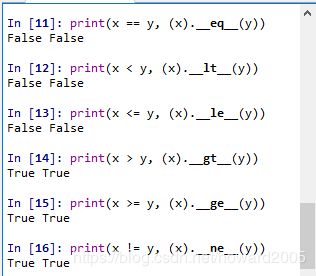Python学习笔记:创建分数类
Python学习笔记:创建分数类
1、编写创建分数类.py
# 创建分数类
from math import gcd
# 定义分数类
class Fraction:
def __init__(self, top, bottom):
if type(top) == int and type(bottom) == int:
common = gcd(top, bottom)
self.num = top // common
self.den = bottom // common
else:
raise ValueError('错误:分子或分母不是整数!')
def getNum(self):
return self.num
def getDen(self):
return self.den
def show(self):
print(self.num, "/", self.den)
def __str__(self):
return str(self.num) + "/" + str(self.den)
def __add__(self, other):
newnum = self.num * other.den + self.den * other.num
newden = self.den * other.den
return Fraction(newnum, newden)
def __sub__(self, other):
newnum = self.num * other.den - self.den * other.num
newden = self.den * other.den
return Fraction(newnum, newden)
def __mul__(self, other):
newnum = self.num * other.num
newden = self.den * other.den
return Fraction(newnum, newden)
def __truediv__(self, other):
newnum = self.num * other.den
newden = self.den * other.num
return Fraction(newnum, newden)
def __eq__(self, other):
firstnum = self.num * other.den
secondnum = other.num * self.den
return firstnum == secondnum
def __lt__(self, other):
firstnum = self.num * other.den
secondnum = other.num * self.den
return firstnum < secondnum
def __le__(self, other):
firstnum = self.num * other.den
secondnum = other.num * self.den
return firstnum <= secondnum
def __gt__(self, other):
firstnum = self.num * other.den
secondnum = other.num * self.den
return firstnum > secondnum
def __ge__(self, other):
firstnum = self.num * other.den
secondnum = other.num * self.den
return firstnum >= secondnum
def __ne__(self, other):
firstnum = self.num * other.den
secondnum = other.num * self.den
return firstnum != secondnum
x = Fraction(3, 5)
y = Fraction(2, 9)
x.show()
y.show()
print("x =", x)
print("y =", y)
print("x + y =", x + y)
print("x - y =", x - y)
print("x * y =", x * y)
print("x / y =", x / y)
print("x == y:", x == y)
print("x < y:", x < y)
print("x <= y:", x <= y)
print("x > y:", x > y)
print("x >= y:", x >= y)
print("x != y:", x != y)2、程序运行结果
3、解释说明
(1)构造方法__init__
- 分子和分母都除以分子分母最大公约数,化成最简分数。
- 如果分子或分母不是整数,会抛出异常。
(2)show()方法,将分数对象按照分数格式输出
(3)__str__方法,将对象转换成字符串打印输出,类似于Java实体类的toString()方法
(4)算术运算方法
__add__、__sub__、__mul__、__truediv__分别对应+、-、*、/运算符
(5)关系运算方法
__eq__、__lt__、__le__、__gt__、__ge__、__ne__对应==、<、<=、>、>=、!=运算符
(6)获取分子与分母的方法
演示类的继承
1、创建LogicGate类
2、继承LogicGate类,创建子类BinaryGate
3、继承BinaryGate类,创建子类AndGate
4、继承BinaryGate类,创建子类OrGate
5、继承LogicGate类,创建子类UnaryGate
6、继承UnaryGate类,创建子类NotGate
7、创建Connector类
8、创建主函数main()
完整代码如下:
# 演示类的继承
class LogicGate:
def __init__(self, name):
self.name = name
self.output = None
def getLabel(self):
return self.name
def getOutput(self):
self.output = self.performGateLogic()
return self.output
# 继承LogicGate类
class BinaryGate(LogicGate):
def __init__(self, name):
super(BinaryGate, self).__init__(name)
self.pinA = None
self.pinB = None
def getPinA(self):
if self.pinA == None:
return int(input("Enter Pin A input for gate " + self.getLabel() + "-->"))
else:
return self.pinA.getFrom().getOutput()
def getPinB(self):
if self.pinB == None:
return int(input("Enter Pin B input for gate " + self.getLabel() + "-->"))
else:
return self.pinB.getFrom().getOutput()
def setNextPin(self, source):
if self.pinA == None:
self.pinA = source
else:
if self.pinB == None:
self.pinB = source
else:
print("Cannot Connect: NO EMPTY PINS on this gate")
# 继承BinaryGate类
class AndGate(BinaryGate):
def __init__(self, name):
BinaryGate.__init__(self, name)
def performGateLogic(self):
a = self.getPinA()
b = self.getPinB()
if a == 1 and b == 1:
return 1
else:
return 0
# 继承BinaryGate类
class OrGate(BinaryGate):
def __init__(self, name):
BinaryGate.__init__(self, name)
def performGateLogic(self):
a = self.getPinA()
b = self.getPinB()
if a == 1 or b == 1:
return 1
else:
return 0
# 继承LogicGate类
class UnaryGate(LogicGate):
def __init__(self, name):
LogicGate.__init__(self, name)
self.pin = None
def getPin(self):
if self.pin == None:
return int(input("Enter Pin input for gate " + self.getLabel()+"-->"))
else:
return self.pin.getFrom().getOutput()
def setNextPin(self, source):
if self.pin == None:
self.pin = source
else:
print("Cannot Connect: NO EMPTY PINS on this gate")
# 继承UnaryGate类
class NotGate(UnaryGate):
def __init__(self, name):
UnaryGate.__init__(self, name)
def performGateLogic(self):
if self.getPin():
return 0
else:
return 1
class Connector:
def __init__(self, fgate, tgate):
self.fromgate = fgate
self.togate = tgate
tgate.setNextPin(self)
def getFrom(self):
return self.fromgate
def getTo(self):
return self.togate
def main():
g1 = AndGate("G1")
g2 = AndGate("G2")
g3 = OrGate("G3")
g4 = NotGate("G4")
c1 = Connector(g1, g3)
c2 = Connector(g2, g3)
c3 = Connector(g3, g4)
print(g4.getOutput())
main()9、运行程序,查看结果

















